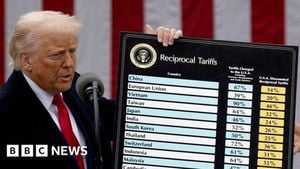Donald Trump’s return to the White House in 2025 has reignited a fierce debate over economic nationalism and the real-world costs of protectionist trade policies. In a move that sent shockwaves through global markets, Trump swiftly enacted sweeping tariffs on foreign goods, targeting America’s allies and rivals alike. The stated goal? To “Make America Great Again” by bringing billions into the US Treasury, revitalizing industry, and creating jobs. But as the dust settles, the evidence points to a far more complicated—and costly—reality for American consumers and businesses.
Trump’s tariff strategy was anything but haphazard. According to reporting by The Express Tribune, the administration imposed tariffs based on each country’s trade balance with the US and their security relationships. Australia, with its defense ties, faced a relatively modest 10% tariff. Japan and South Korea, despite similar alliances, were hit with 15% due to their larger trade surpluses. Other Asian nations averaged a hefty 22.1%, though countries willing to negotiate—like Pakistan, Thailand, Indonesia, Malaysia, and the Philippines—secured a “discount” rate of 19%.
Perhaps most surprising was the treatment of India, a strategic US partner, which saw tariffs soar to 50%—the highest after Brazil. The reason? India’s refusal to halt purchases of Russian crude oil. The message was clear: economic and geopolitical choices would carry a price.
Many of America’s trading partners, including the European Union, ultimately accepted these unfavorable terms, wary of economic retaliation and the risk of losing access to the lucrative US market. Even Canada, which initially retaliated, has begun to scale back its own countermeasures. But China, the primary target of Trump’s tariffs, refused to back down, responding with substantial counter-tariffs of its own. This standoff led to two consecutive 90-day “truces” as both nations continue a tense negotiation dance.
On the surface, Trump appeared to have won the first round of the trade war on the diplomatic front. Yet the economic goals at home remain elusive. As CNN and The Express Tribune both report, the tariffs have fueled inflation, disrupted supply chains, and stalled job creation—outcomes that hit American workers and consumers hardest.
Trump has repeatedly insisted, most recently in an August post on his social media platform, that “Tariffs have not caused Inflation, or any other problems for America, other than massive amounts of CASH pouring into our Treasury’s coffers.” He also claimed, “Consumers aren’t even paying these Tariffs, it is mostly Companies and Governments, many of them Foreign, picking up the tabs.” But the data tells a different story.
Economic research and firsthand business experiences show that American firms and consumers are the ones feeling the pinch. Import prices, which exclude tariffs, insurance, and shipping, have held mostly steady—rising by 0.5% since the November election and 0.2% since March 2025, when the bulk of new tariffs were announced, according to Pantheon Macroeconomics (as cited by CNN). For most countries, import prices have been flat, suggesting that US importers—not foreign exporters—are absorbing the costs.
Olu Sonola, head of US economic research at Fitch Ratings, told CNN, “All of that is paid by importers. It’s now a question of, is it the manufacturer, is it the retailers, or is it the small business that’s bringing it in? They now have to figure out, ‘How much of this can I take on, and how much of this will I pass on?’” The answer, increasingly, is that the bulk of costs are passed on to consumers.
Initially, American consumers absorbed about 22% of tariff costs through June 2025, but Goldman Sachs economists projected this share would rise to 67% by October—and potentially up to 100% if you count the spillover effects as domestic producers raise their own prices. As Harvard Business School research found, by August 8, 2025, imported goods cost 5% more than pre-tariff trends predicted, while domestic goods were running 3% higher.
These increases aren’t always dramatic or immediate. Businesses stocked up on pre-tariffed goods, and many tariffs were phased in, softening the initial blow. But the slow, steady rise in prices—what some economists call “sneakflation”—is quietly eroding household budgets. Recent Consumer Price Index reports show that overall prices rose by 2.7% in July 2025, with food costs climbing by 2.9%. Household furnishings, linens, tools, toys, and sporting goods have all become more expensive.
Walmart CEO Doug McMillon, speaking on August 28, 2025, acknowledged that tariffs have increased costs weekly but pledged to keep prices down “for as long as we can.” Still, as Matt Bush, a US economist at Guggenheim Investments, told CNN, “Businesses say they’re working both with suppliers and consumers to help share some of the cost burden. But I think as the realization sets in that these tariffs are not going back down, they will start to pass more on to consumers.”
The impact is especially harsh on lower-income Americans, who spend a larger share of their income on essentials. Heather Long, chief economist at Navy Federal Credit Union, described the constant juggling act many families face: “Lower-income Americans are sadly adept at juggling their expenses and trying to make every dime count. They may go without meat or coffee one week in order to buy shoes for their kids. The next week, they may skip a car payment to cover their electric bill and a medical expense. It’s a constant juggle where they allocate money to their most urgent need at that moment.”
Trump’s logic was that tariffs would protect American jobs, especially in manufacturing. But the July 2025 jobs report told a different story: job creation has stalled, with net gains falling short of expectations and slowdowns in key sectors like manufacturing and construction. Retaliation from China, Canada, and Mexico targeted US agriculture, technology, and manufacturing, making it harder for American exporters to compete abroad. Farmers have seen reduced demand for soybeans, pork, and dairy, leading to farm closures and a growing reliance on federal subsidies.
A March 2025 analysis by CNBC found broad consensus among economists—both conservative and liberal—that the tariffs are more likely to drag down GDP and cause net job losses than to deliver the promised benefits. As the analysis put it, tariffs act like a regressive tax, hitting lower-income households the hardest.
Politically, Trump’s tariffs offer a simple message: “We’re Making America Great Again.” But the economic reality is more complex. Manufacturers, facing higher costs, are often passing them on to consumers, reducing labor hours, freezing hiring, or slashing investments. The result? A feedback loop of higher prices, reduced investment, and slower hiring—conditions ripe for economic stagnation.
Wall Street strategists are already warning of an approaching period of sticky inflation and sluggish growth—stagflation, in other words. The Federal Reserve Bank of Atlanta found that businesses expect to raise prices by 3.5% in 2025, up from 2.5% at the end of 2024, with little difference between firms exposed to foreign markets and those that aren’t.
Yet, there may be a legal check on Trump’s tariff ambitions. Last week, a federal appeals court struck down several of his tariffs, ruling that he unlawfully relied on emergency powers. The administration has vowed to appeal, and the final decision now rests with the Supreme Court.
As the country heads into another election season, the debate over tariffs is more than just a political talking point. It’s a pocketbook issue for millions of Americans, revealing the high price of economic nationalism in a globalized world.




